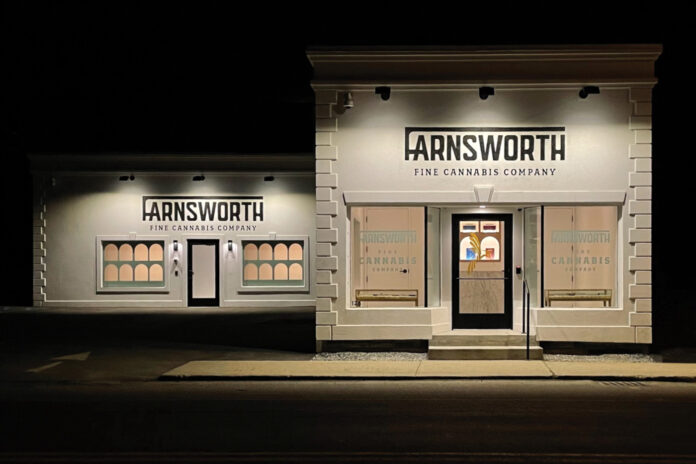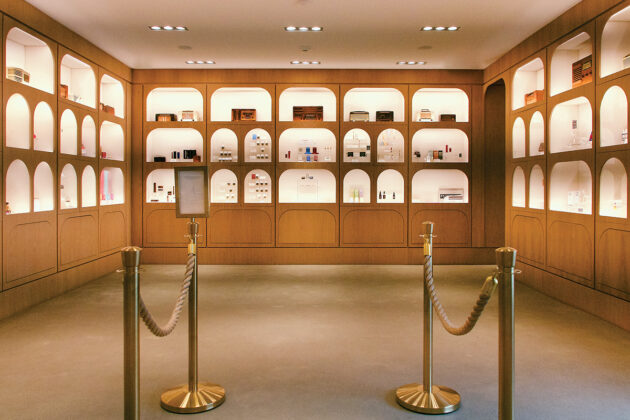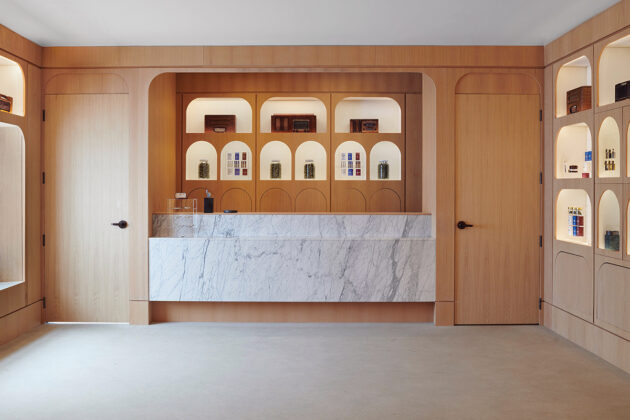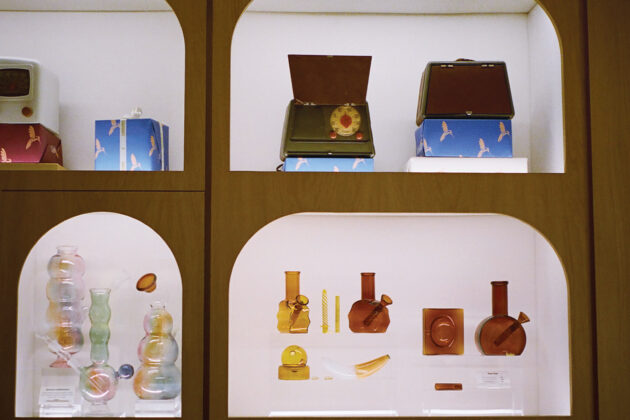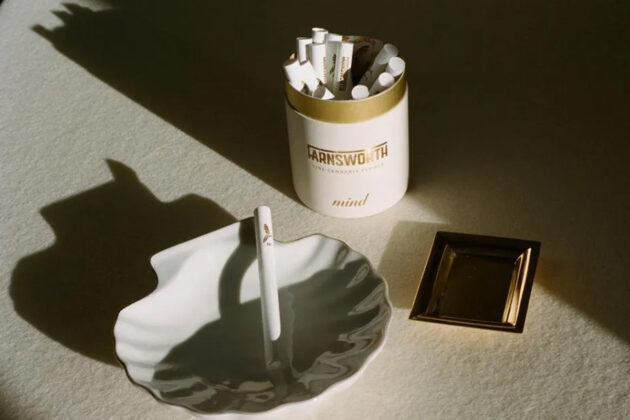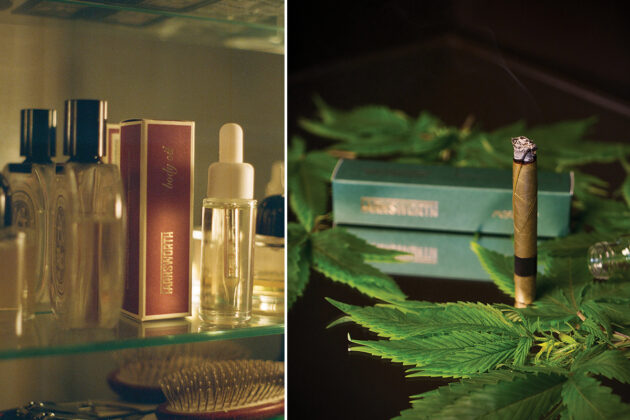After working as an art director and photo director for hip hotelier André Balazs, Alexander Farnsworth had high-minded dreams of applying his talents to designing his own cannabis dispensary.
Four years of effort later, his hummingbird-branded Farnsworth Fine Cannabis took flight in Great Barrington, Massachusetts, in 2021. The target market: tourists and well-heeled owners of second homes in the Berkshires, which Farnsworth calls “the Hamptons in the Hills.”
He and longtime partner Adam Lippes live nearby, just two and one-half hours from their other homebase on Manhattan’s Upper East Side.
“We wanted to elevate the dispensary experience to appeal to customers who shop at top-tier fashion and beauty boutiques,” said Farnsworth, a longtime cannabis advocate. “The area draws a very cultural crowd. Our clientele has an interest in fashion, hospitality, and the art design industries.”
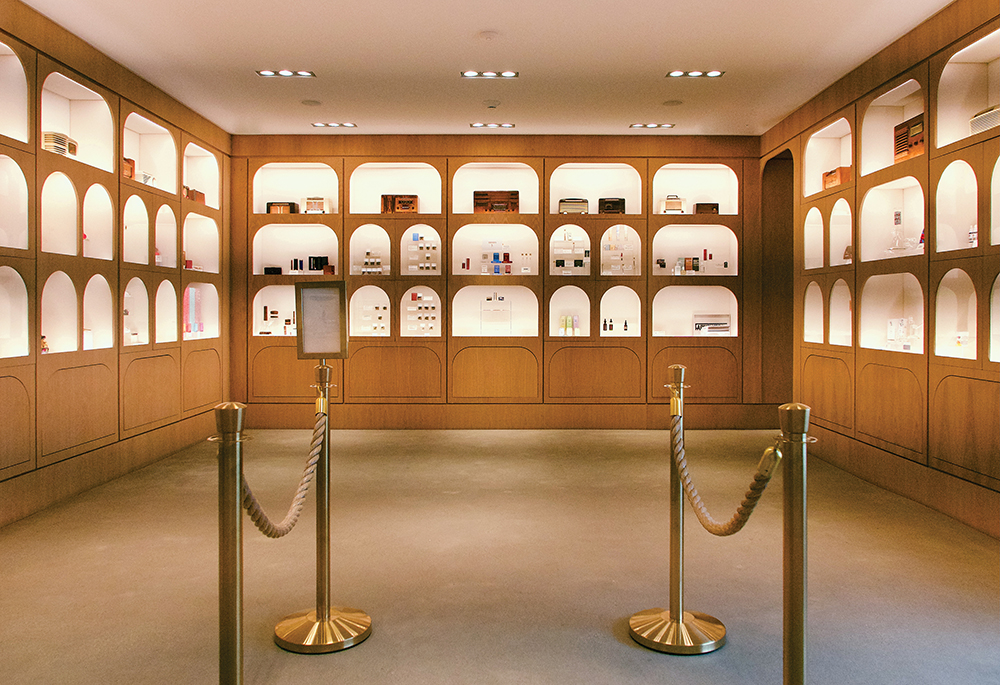
Lippes’ retail background and Farnsworth’s origins as an art director—after modeling and acting—helped inform their dispensary vision. But the original name, Highminded, had to be reconsidered when the Massachusetts Cannabis Control Commission nixed the word “high” due to signage rules meant to obscure the product.
“Highminded was meant as an intellectual elevation—an expansion of thinking,” Farnsworth said. “We had about twenty-four hours to pick a new name if we wanted to move forward in the licensing process. But I can’t say I wasn’t warned.”
The process may have been arduous, but Farnsworth Fine Cannabis has been a labor of love—and of family. Farnsworth is chief executive officer and the design visionary—art director, if you will—but he co-owns the dispensary and the company behind it, Highminded LLC, with his brother, Brayden, and sister, Isabella. The brothers run the dispensary day-to-day.
Alexander Farnsworth chose hummingbirds for the store’s logo and theme in homage to his maternal grandfather, whose last name was Bird. In addition, he said, hummingbirds “are elusive and elegant. And they vibrate and hover, akin to the activation of cannabinoids in our bodies.”
The dispensary hatched from a 1950s-era building that famously stylish architect Simon Aldridge—who also worked on Farnsworth’s nearby home—took back to the studs.
“His work is traditional through a minimalist lens,” Farnsworth said. “We wanted the dispensary to feel new but also like it has always existed. We also wanted it to be light and airy, not shiny, sexy, and dark like Saint Laurent.”
Farnsworth visited other dispensaries to make a list of dos and don’ts. Lippes isn’t involved with the dispensary, but according to Farnsworth, “he was really helpful in conveying the original vision to the architect.”
“We had a vision and we cleaved to it,” he said. “Coming from a design background, it was something we were unwilling to sacrifice.”
Cleaving came at a cost. “Most of the budget went into the showroom,” Farnsworth said. “If our wares don’t sell, the design doesn’t function.”
Arches—seventy-eight in all—draw eyes to the small-scale product. Each arch is lined with ivory silk fabric, and lights are positioned above and below the merchandise. Strategic frosted windows also help the materials to glow during the day.
“Lighting is very important to selling,” Farnsworth said. “We’re going for crisp and clean, but always warm, and an overall quality that’s built to last.”
Oakwood walls, a fourteen-foot-wide Italian Carrara marble sales counter, and unpolished concrete floors further contribute to an airy and chic timelessness.
The dispensary differs from a high-end designer boutique in that it doesn’t have visible retail computer screens.
“There are enough screens around us,” Farnsworth said. “Not having them goes with the sense that you aren’t sure if the dispensary is new or always existed.”
After customers check in at a marble desk, they follow a corridor to the showroom. The hallway itself is memorable, with a custom-made golden neon hummingbird mounted in an infinity mirror on the wall, “so it’s like you’re walking into a giant, fluttering infinity of hummingbirds,” Farnsworth said. “It’s playful.”
Leading neon supplier and creator Let There be Neon of New York built the six-foot-tall hummingbird piece, which also conveys to customers that the dispensary has layers and depths to explore.
The building’s exterior feels “very Los Angeles,” Farnsworth said, “with crisp lines and white stucco. If you added a big green hedge, you’d think you were on Los Angeles’s [luxe shopping avenue] Robertson Boulevard.”
The dispensary’s exterior complements a building the Farnsworth family purchased across the street. The 1950s-era Getty gas station received a similar exterior remodeling, replacing vintage Getty signs with Farnsworth signs.
“That’s an event space,” he said. “It’s for food trucks and coffee trucks, tables that look over the river, and a customer parking lot. It’s like having Bergdorf’s on one side and Bergdorf’s Men’s Store on the other.”
The state’s cannabis commission had to approve the dispensary’s design. As required, products could not be visible from the exterior, and a desk was needed (the ivory Carrara marble) where IDs would be checked.
“The requirements were less visual design than operational,” Farnsworth said of his long trip through the regulatory maze. And he’s thrilled with the result, even after the commission’s insistence on thirty-five security cameras for a 1,500-square-foot showroom.
“Those cost a fortune and are kind of unnecessary because we’re selling a plant like kale, not plutonium.”
“Why would we need so many security cameras for such a small building?”
Not including the cost of the original building, “we spent about $650,000—and that was at pre-COVID prices,” Farnsworth said. (He signed a contract with the contractor one week before the pandemic hit.) “Today, the cost of the design and materials would easily be $1 million.”
The dispensary’s hummingbird logo and typeface were created in collaboration with David Meyer, a graphic artist and former colleague at Balazs Properties. The bird adorns a nest of products, including the dispensary’s eponymous line of cannabis cigarettes. Hummingbirds adorn the packaging as well as the custom hemp paper that wraps each smoke.
Farnsworth Fine Cannabis pre-rolls—the brand’s debut product—are available in light, classic, and bold variants at $11 each or $50 for a five-pack. Products get stronger as the lineup goes along, with an ivory color having the lowest THC, while a bold maroon color evoking Marlboro red offers the strongest effects. Between them is the mid-strength product in a French Gitanes cigarette-like blue.
All have luxury-length filters to “keep the heat away from your face” and are packaged with polished sophistication geared to high-end tastes. “They look like traditional cigarettes, but they’re true CBG product,” Farnsworth said.
The joints “are functional, design-driven, and packaged for everyday use,” he added.
Paraphernalia in the shop ranges from $2 rolling papers to $2,000 Italian hand-blown bongs. The dispensary also sells its own branded lavender-and-THC body oil, $45 for 30 ml.
Farnsworth and Lippes often travel, and he likes to pick up ashtrays, lighters, or other smoking paraphernalia wherever he goes, whether it’s New York City, Mexico City, Houston, or South America. Most items end up in the shop, including a table lighter that once belonged to counterculture novelist Jack Kerouac. (Sorry, that piece is sold.)
Shopping for the dispensary isn’t merely a pleasurable pastime for Farnsworth. “It’s also vital to keep retail fresh,” he explained. “For a luxury market, the curation is obviously important.”
The trips have paid off in other ways, too. “From a design perspective, had I not been to Venice and Tangiers multiple summers, Farnsworth Fine Cannabis would not have been the same,” he said.
Take one of its main design motifs: the entry archways. They’re associated with Venetian pharmacies dating back to the 1300s. “You can pick up our dispensary and put it into Venice, Paris, London, or New York City, and it would feel very much at home and very fitting,” Farnsworth said.
After three years in business as of March, how well has the design served its intended purpose?
“I’m happy to report it has lived up to our wildest expectations,” Farnsworth said, adding he’s exploring other retail opportunities on the East Coast.
Based on what he knows about the industry now, would he have done anything differently for Farnsworth Fine Cannabis?
“Honestly, no,” he said. “It’s been a dream come true.”







